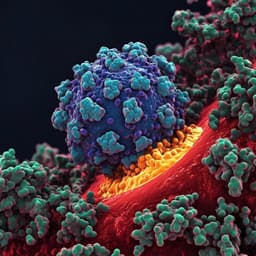
Agriculture
Transcriptome and genome sequencing elucidates the molecular basis for the high yield and good quality of the hybrid rice variety Chuanyou6203
J. Ren, F. Zhang, et al.
This groundbreaking study by Juansheng Ren, Fan Zhang, and colleagues explores the genetic secrets behind the exceptional yield and quality of the hybrid rice variety Chuanyou6203. Utilizing advanced transcriptomics and genomic analysis, the research uncovers key molecular mechanisms that could revolutionize rice cultivation for enhanced food security.
~3 min • Beginner • English
Introduction
Hybrid rice exploits yield heterosis, but improved yield often comes at the expense of grain quality. The molecular mechanisms underpinning simultaneous high yield and good quality in hybrid rice remain unclear. This study investigates the molecular basis of yield heterosis and eating/cooking quality in the elite hybrid Chuanyou6203 (CY6203) by integrating comparative genomics and transcriptomics with its parental lines (CH3203 and C106B). The goal is to uncover genetic variation, gene expression patterns, coexpression networks, and pathways that contribute to source–sink regulation, nitrogen metabolism, photosynthesis, and starch quality traits, thereby informing breeding strategies for hybrids that achieve both high productivity and superior quality.
Literature Review
Prior work has linked heterosis to widespread differential gene expression and regulatory variation in hybrids. Studies in rice (e.g., LYP9) and other crops identified thousands of DEGs between hybrids and parents and associated promoter polymorphisms with additive and dominance-like expression patterns. Large-scale genomic analyses have highlighted the role of numerous superior alleles, with a subset showing strong overdominance for key agronomic traits (e.g., Ehd1, Hd1, Ghd7, OsSPL14, Gn1, qSW5, Wx). Overdominance has been implicated particularly for grain number heterosis. For grain quality, Wx and SSII-3 (ALK) are major determinants of amylose content (AC), gel consistency (GC), and gelatinization temperature (GT), with allelic diversity at these loci shaping regional preferences. Manipulating starch branching enzyme OsBEIIb affects starch structure and GC. Collectively, the literature suggests heterosis arises from complex interactions among allelic variants, regulatory divergence, and pathway-level coordination in photosynthesis, nitrogen metabolism, and starch biosynthesis.
Methodology
Plant materials: CY6203 (F1 hybrid from Chuan106A WA-CMS line and restorer line CH3203), its isonuclear maintainer C106B, and CH3203 were grown in field conditions at Sichuan Academy of Agricultural Sciences. Sowing dates were staggered (April 5, 10, and 25, 2019) to synchronize developmental stages. Standard agronomic management was applied.
Phenotyping: Agronomic traits measured included single plant weight per day (SPW/D), plant height (PH), panicle length (PL), average number of spikelets per panicle (ANSPP), and 1000-grain weight (TGW). Grain quality traits (head rice ratio HRR, grain length/width L/W, amylose content AC, alkali spreading value ASV, gel consistency GC) were measured with three replications by the Rice Product Quality Inspection & Supervision Testing Center. Over-male-parent and over-female-parent heterosis were calculated.
Sampling: Tissues (panicles and flag leaves) were collected at three stages: 7 days before heading (panicles S; leaves Y), 3 days after heading (panicles E; leaves H), and 15 days after heading (panicles W), with three biological replicates per material per stage, sampled 9:00–10:00 and stored at −80°C.
Sequencing: Genomic resequencing was performed for parents (Illumina HiSeq 4000; paired-end 150 bp). RNA-seq was performed for 45 transcriptome libraries (Illumina HiSeq 4000). DNA/RNA quality was assessed on Agilent 2100.
Read processing and mapping: Raw reads were quality-checked (FastQC) and filtered to remove adapters, reads with >10% Ns, and reads with >50% bases at Q≤20. rRNA reads were removed (Bowtie2). Remaining reads were mapped to the Nipponbare MSU7 reference (Bowtie2). Transcripts were assembled via reference-guided method (Cufflinks), quantified (RSEM), and normalized to FPKM. DEGs were identified using edgeR with thresholds |log2FC| > 1 and FDR < 0.05. Outlier libraries (E6203-2, Y6203-1) were excluded after hierarchical clustering.
Variant discovery: Parental SNPs/InDels were called against MSU7 (SAMtools; MAPQ≥25) and annotated (ANNOVAR). Distinct variant sites between parents were identified and density plotted per 200 kb (RIdeogram) with overlays of cloned yield/quality/KEGG pathway genes.
RNA editing: Putative RNA editing sites were inferred from RNA-seq SNPs following filters: correction around InDels, non-overlapping exonic/UTR SNPs, reference reads ≥2 and variant reads ≥3, editing ratio between 0.1 and 0.9, then per-sample frequency distributions were computed.
Coexpression network: DEGs between F1 and parents across tissues/stages were filtered (expressed in ≥10% samples, non-zero variance) and analyzed by WGCNA (unsigned TOM, power β=18, R2=0.85, min module size=30, merge cut height=0.25). Module eigengenes were computed and expression patterns visualized; modules clustered into three groups.
Enrichment analysis: KEGG pathway enrichment (ExPath 2.0; FDR≤0.05) and GO enrichment (agriGO v2; FDR≤0.05) were performed on module genes; visualization by ggplot2 and Pathview for pathway-level expression patterns.
qRT-PCR validation: Eighteen DEGs were validated using SYBR-based qRT-PCR (3 biological replicates), normalized to Actin, analyzed by 2^-ΔΔCt. RNA-seq and qRT-PCR fold changes were compared.
Data availability: Raw data deposited under PRJCA003209 (CRA003262) in GSA (BIG Data Center).
Key Findings
- Parental genomic variation: 66,319 distinct SNPs/InDels between CH3203 (34,102) and C106B (32,217) in UTRs, exons, introns, and 3' UTRs, involving 7,473 genes. Variation hotspots on chromosomes 1, 2, 4, 8, 10, 11; up to 578 variants per 200 kb region (chr2: 3.0–3.2 Mb).
- Transcriptome data quality: Average 67.65 million clean reads per library; mean mapping ratio 82.8% (77.59–86.61%). On average, 26,344.7 unique genes detected per sample. qRT-PCR validation showed strong correlation with RNA-seq (R2≈0.625–0.631, P<0.0001). Total 39,503 DEGs across all comparisons.
- DEG contrasts by stage/tissue: Between CY6203 and C106B: 1,164 (panicle booting), 642 (panicle flowering), 4,515 (panicle middle filling), 2,180 (leaf booting), 2,615 (leaf flowering) DEGs; upregulated fractions 71.22%, 71.5%, 36.72%, 68.26%, 55.56%, respectively. Between CY6203 and CH3203: 7,617, 915, 1,738, 7,742, 8,049 DEGs; upregulated fractions 60.15%, 73.55%, 49.94%, 73.13%, 73.64%, respectively. Common DEGs between CY6203 and both parents per stage/tissue: 436, 70, 551, 993, 1,216. In these, upregulated DEGs in CY6203 vs CH3203 exceeded those vs C106B at all stages in panicles and leaves.
- mRNA editing: CY6203 exhibited a high density of editing loci (63.05 per Mb) vs parents (C106B 8.13/Mb; CH3203 7.94/Mb). Editing ratios showed near-normal distributions centered around 0.5; 40.61% of events had ratios 0.4–0.6. Notably, 1.68% events showed editing ratio ≥0.8, favoring one parent across all or specific stages, consistent with dominance/epistasis. Example: Wx exon 9 site editing ratio ≈0.5119 in CY6203 vs ≈0.8144 in C106B.
- Coexpression modules (WGCNA): 15,934 DEGs grouped into 19 modules (18 functional plus grey). Modules clustered into three groups. The green-yellow module (298 genes) was significantly enriched for photosynthesis-antenna proteins, photosynthesis, nitrogen metabolism, carbon fixation, with GO terms for photosynthesis and light harvesting. CY6203 showed stage-specific expression shifts: initial inhibition then increase in photosynthesis pathways; sustained higher expression than parents in nitrogen metabolism and carbon fixation, including carbonic anhydrases (LOC_Os01g45274, LOC_Os04g33660, LOC_Os08g36680) and Rubisco small subunits (LOC_Os12g17600, LOC_Os12g19381, LOC_Os12g19470). Nitrogen metabolism was also enriched in the yellow module (FDR=0.02), including PSR1, OsNRT2.3, OsNRT2.4, OsGS1;2, OsGS2 carrying parental variants; CY6203 editing ratios ≈0.5 and expression higher than C106B and similar to CH3203 at middle filling.
- Cloned gene expression patterns: For some yield-related genes, CY6203 expression was intermediate (e.g., HGW higher than C106B, lower than CH3203), others showed opposite trends (e.g., Gnl a, Gnp4 with over-/mid-parent expression at booting). Chlorophyll-related genes (Fd1, LHCB, CAB2R) were higher in CY6203 than C106B but lower than CH3203 at middle filling. Quality-related genes showed balanced patterns: Wx and GL7 were lower than C106B and higher/lower than CH3203 depending on stage; ALK was upregulated in CY6203 vs both parents at middle filling, aligning with ASV over-parent heterosis.
- Phenotypic heterosis: CY6203 outperformed parents in key traits. OMPH/OFPH: SPW/D 8.85%/14.42%; ANSPP 27.77%/18.64%; AC 44.63%/6.71%; ASV 6.15%/15%. Table values: CY6203 SPW/D 0.246 g/d, ANSPP 166.1, TGW 29 g, HRR 58%, L/W 3.5, AC 17.5%, ASV 6.9, GC 75 mm.
- Mechanistic inference: Increased source strength via enhanced photosynthetic efficiency and nitrogen utilization (green-yellow module) plus amplified sink via spikelet number genes (e.g., Gnp4, Gn1a) underpin yield heterosis. Balanced expression of C106B and CH3203 starch biosynthesis alleles (Wx, OsSSI, OsSSIIIa, SSIIB), together with ALK upregulation, explains favorable AC, GC, and ASV quality profile.
- Parental contribution shifts: More DEGs vs CH3203 at booting, but the opposite at middle filling, indicating stage-specific contributions of parental alleles to F1 performance.
Discussion
This integrative genomics–transcriptomics analysis clarifies how CY6203 achieves both high yield and desirable grain quality. Parental genomic divergence (7,473 genes with SNPs/InDels) generates extensive heterozygosity and mRNA editing in the F1, with most editing near 0.5, but a subset biasing toward one parent, consistent with dominance and epistasis models of heterosis. Network analysis highlights a coexpressed module (green-yellow) that coordinates photosynthesis, antenna size, carbon fixation, and nitrogen metabolism. CY6203’s expression dynamics in these pathways, particularly sustained elevation in nitrogen metabolism and carbon fixation across stages, likely enhance source capacity (CO2 assimilation and N use efficiency), aligning with observed SPW/D and ANSPP heterosis. Concurrent modulation of spikelet number genes (e.g., Gn1a decreased activity, Gnp4 increased expression) expands sink size. For quality, balanced expression of major starch biosynthesis alleles from both parents (Wx, OsSSI, OsSSIIIa, SSIIB) combined with elevated ALK expression at grain filling reconciles typically antagonistic relationships among AC, GC, and ASV, delivering an improved eating/cooking profile. Stage-dependent differences in DEG counts and directionality between CY6203 and each parent further support a dynamic, developmentally regulated contribution of parental alleles to F1 performance. Overall, the findings provide mechanistic support for a source–sink and balanced-allele expression model underpinning combined yield heterosis and high grain quality in rice hybrids.
Conclusion
The study identifies extensive parental genetic variation (66,319 SNPs/InDels across 7,473 genes) and widespread, stage-dependent transcriptional reprogramming in the hybrid CY6203 relative to its parents. CY6203 shows pronounced heterosis for yield components and key quality traits. WGCNA links a green-yellow module enriched in photosynthesis, antenna proteins, nitrogen metabolism, and carbon fixation to yield heterosis, indicating enhanced source strength. A small set of grain number genes amplify sink size. Balanced expression of key starch biosynthesis alleles from both parents, together with ALK upregulation, explains CY6203’s superior quality. The mRNA editing landscape, with most events near 0.5 but a subset favoring one parent, suggests dominance/epistasis contributes to heterosis. These results provide a data resource and mechanistic framework for breeding hybrids combining high yield and quality. Future work should functionally validate candidate module genes, dissect causative regulatory variants, perform allele-specific and single-cell expression analyses across grain filling, and test targeted manipulation (e.g., antenna size, nitrogen transporters) to optimize source–sink balance and quality.
Limitations
Related Publications
Explore these studies to deepen your understanding of the subject.







